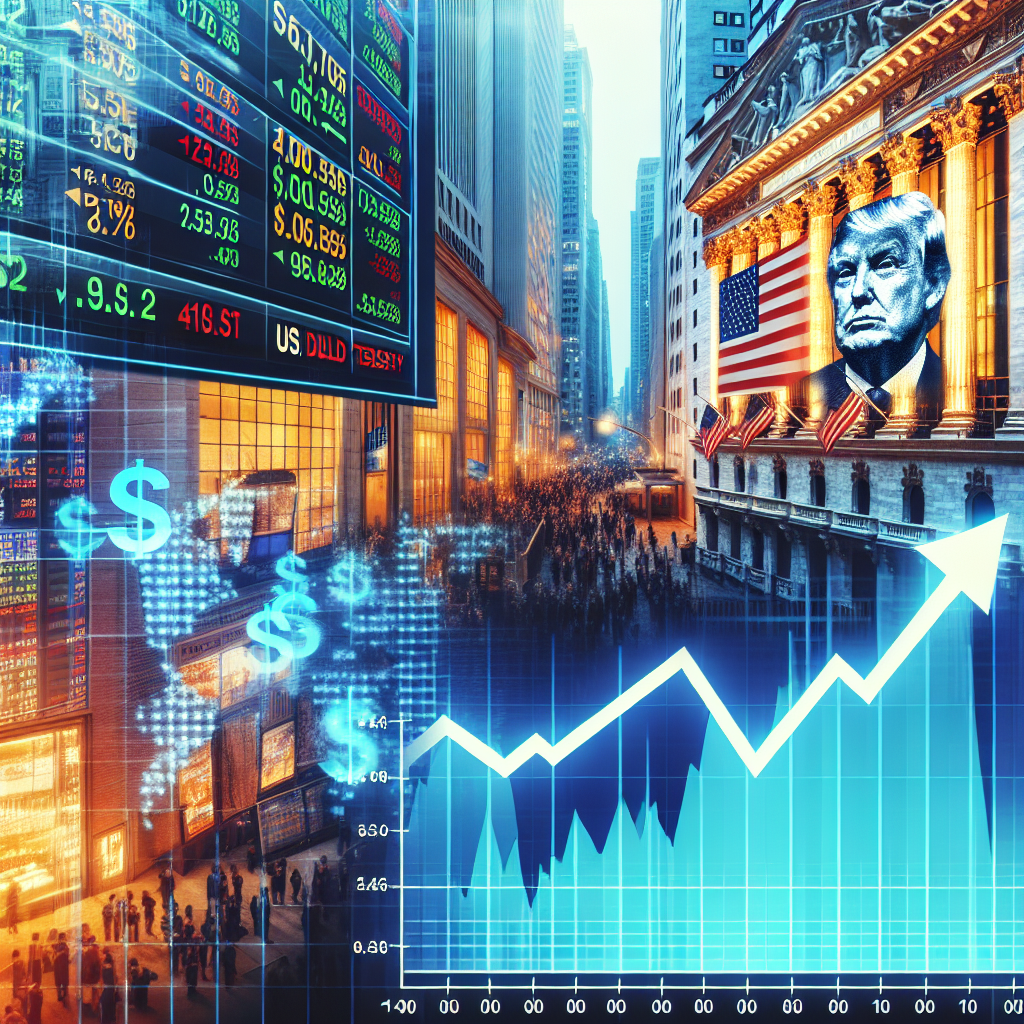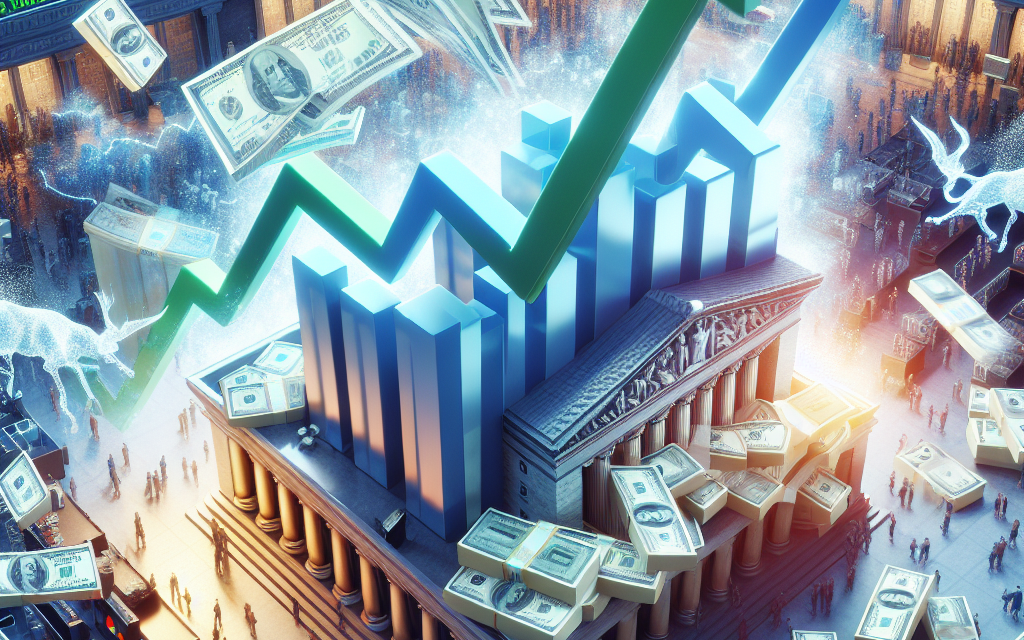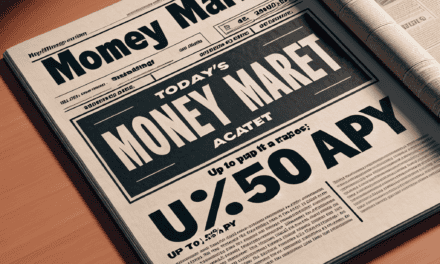“Market Surge: Trump 2.0 Speculation Fuels Stocks and Dollar, Pressures Treasuries”
Introduction
The financial markets have been abuzz with speculation surrounding a potential “Trump 2.0” scenario, which has led to a notable boost in U.S. stocks and the dollar, while U.S. Treasuries have experienced a decline. Investors are reacting to the possibility of former President Donald Trump making a political comeback, which many believe could lead to a continuation or revival of his administration’s economic policies. These policies, characterized by tax cuts, deregulation, and a focus on domestic energy production, are perceived by some market participants as favorable for economic growth and corporate profitability. As a result, the anticipation of such a political shift has injected optimism into the equity markets and strengthened the dollar, while simultaneously putting pressure on bond prices as investors adjust their expectations for future fiscal and monetary policy directions.
Impact Of Trump 2.0 Speculation On US Stock Market Trends
The recent surge in speculation surrounding a potential second term for Donald Trump, often referred to as “Trump 2.0,” has had a notable impact on the US financial markets. Investors, analysts, and policymakers are closely monitoring these developments, as the anticipation of Trump’s return to the political arena has led to significant movements in stocks, the US dollar, and Treasury yields. This speculation has injected a new wave of optimism into the stock market, with many investors betting on a continuation of the pro-business policies that characterized Trump’s first term. Consequently, US stocks have experienced a boost, reflecting increased investor confidence in the potential for favorable economic conditions.
During Trump’s initial presidency, the stock market witnessed substantial growth, driven by tax cuts, deregulation, and a focus on domestic economic expansion. As a result, the possibility of a Trump 2.0 scenario has rekindled hopes for similar policies that could further stimulate corporate profits and economic growth. Investors are particularly optimistic about sectors such as energy, finance, and manufacturing, which benefited significantly from Trump’s policies. This optimism is reflected in the rising stock prices of companies within these industries, as market participants anticipate a favorable business environment that could enhance profitability.
In addition to the stock market, the US dollar has also experienced an upswing amid the Trump 2.0 speculation. The dollar’s strength can be attributed to expectations of robust economic growth and potential interest rate hikes under a Trump administration. A stronger dollar is often seen as a sign of confidence in the US economy, attracting foreign investment and bolstering the currency’s value. This appreciation of the dollar has implications for international trade, as it affects the competitiveness of US exports and the purchasing power of American consumers abroad.
However, while stocks and the dollar have benefited from the Trump 2.0 speculation, US Treasury yields have experienced a decline. This decline can be attributed to a combination of factors, including uncertainty surrounding the potential impact of Trump’s policies on fiscal stability and inflation. Investors may be concerned about the possibility of increased government spending and rising budget deficits, which could lead to higher inflation and erode the value of fixed-income investments. As a result, some investors are seeking refuge in safer assets, such as gold, while others are adjusting their portfolios to account for potential changes in interest rates and inflation expectations.
Moreover, the speculation surrounding Trump’s potential return to power has also raised questions about the broader geopolitical landscape. Trump’s first term was marked by a shift in US foreign policy, characterized by trade tensions and a focus on “America First” initiatives. Investors are now contemplating how a Trump 2.0 scenario might impact global trade relations and international cooperation. These considerations add an additional layer of complexity to investment decisions, as market participants weigh the potential risks and rewards associated with a changing geopolitical environment.
In conclusion, the speculation surrounding a potential Trump 2.0 presidency has had a multifaceted impact on US financial markets. While stocks and the dollar have experienced gains, Treasury yields have declined amid concerns about fiscal stability and inflation. As investors navigate this evolving landscape, they must carefully consider the potential implications of a Trump 2.0 scenario on economic growth, trade relations, and market dynamics. Ultimately, the outcome of this speculation will depend on a range of factors, including political developments, policy decisions, and global economic conditions, all of which will continue to shape the trajectory of US financial markets in the coming months.
How The Dollar Strengthens Amid Trump 2.0 Speculation
The recent surge in U.S. stocks and the dollar, coupled with a decline in Treasury yields, has been largely attributed to speculation surrounding a potential second term for former President Donald Trump. This phenomenon, often referred to as “Trump 2.0,” has sparked considerable interest and debate among investors and analysts alike. As market participants attempt to navigate the implications of a possible Trump return to the White House, the financial landscape is witnessing notable shifts.
To begin with, the strengthening of the U.S. dollar can be attributed to several factors linked to the Trump 2.0 speculation. Historically, Trump’s economic policies have been characterized by tax cuts, deregulation, and a focus on domestic manufacturing, all of which are perceived as favorable to economic growth. Investors, anticipating a similar policy trajectory in a second Trump term, are increasingly bullish on the dollar. This optimism is further fueled by expectations of increased fiscal stimulus and infrastructure spending, which could bolster economic activity and, consequently, the value of the dollar.
Moreover, the anticipation of a Trump 2.0 scenario has led to a rally in U.S. stocks. Market participants are betting on the continuation of pro-business policies that characterized Trump’s first term. These policies, which included corporate tax reductions and a rollback of regulatory constraints, were instrumental in driving stock market gains during his presidency. As a result, investors are positioning themselves to capitalize on potential market-friendly measures that could be reintroduced or expanded upon in a second term. This speculative behavior has contributed to the upward momentum in stock prices, reflecting a broader confidence in the U.S. economic outlook under a Trump administration.
Conversely, the decline in Treasury yields can be seen as a reaction to the shifting expectations surrounding fiscal policy and inflation. While a Trump 2.0 presidency might promise economic growth, it also raises concerns about increased government borrowing to finance ambitious spending plans. This potential rise in fiscal deficits could lead to higher inflationary pressures, prompting investors to demand higher yields on government bonds as compensation for the increased risk. However, the current decline in yields suggests that investors are still weighing the balance between growth prospects and inflation risks, leading to a complex interplay in the bond market.
In addition to these economic considerations, geopolitical factors also play a role in shaping market dynamics. Trump’s foreign policy approach, characterized by a focus on bilateral trade agreements and a more assertive stance on global issues, could influence investor sentiment and currency valuations. A return to such policies might lead to increased volatility in international markets, further impacting the dollar’s strength as investors seek safe-haven assets amid geopolitical uncertainties.
In conclusion, the speculation surrounding a potential Trump 2.0 presidency is having a significant impact on financial markets, with the U.S. dollar strengthening, stocks rallying, and Treasury yields declining. As investors navigate this evolving landscape, they must consider the potential implications of a second Trump term on economic policy, fiscal dynamics, and geopolitical relations. While the future remains uncertain, the current market movements underscore the profound influence of political developments on financial markets, highlighting the intricate connections between policy expectations and economic outcomes. As such, market participants will continue to closely monitor political developments and adjust their strategies accordingly, seeking to capitalize on opportunities while managing risks in an ever-changing environment.
Analyzing The Decline In US Treasuries With Trump 2.0 Buzz
The recent surge in speculation surrounding a potential second term for former President Donald Trump, often referred to as “Trump 2.0,” has had a notable impact on the financial markets, particularly influencing US stocks, the dollar, and Treasury yields. As investors and analysts attempt to decipher the implications of a possible Trump return to the White House, the financial landscape is experiencing a shift that warrants a closer examination.
To begin with, the anticipation of a Trump 2.0 presidency has invigorated US stocks, as market participants recall the pro-business policies that characterized his first term. These policies, which included tax cuts and deregulation, were generally well-received by the business community and investors alike. Consequently, the prospect of a similar economic environment has led to increased optimism in the stock market. This optimism is reflected in the upward trajectory of major stock indices, as investors position themselves to capitalize on potential policy shifts that could favor corporate profitability and economic growth.
Simultaneously, the US dollar has experienced a boost, driven by expectations of a more robust economic performance under a Trump administration. A stronger dollar is often associated with higher interest rates and increased foreign investment, as global investors seek to benefit from the perceived stability and growth prospects of the US economy. The anticipation of a Trump 2.0 presidency has thus contributed to a strengthening of the dollar, as market participants adjust their portfolios in anticipation of potential policy changes.
However, the impact on US Treasuries has been markedly different. The speculation surrounding Trump’s potential return has led to a decline in Treasury prices, resulting in higher yields. This decline can be attributed to several factors. Firstly, the expectation of increased government spending and tax cuts under a Trump administration raises concerns about the fiscal deficit and national debt. Investors may anticipate that such policies could lead to higher inflation and interest rates, prompting them to demand higher yields on government bonds to compensate for the increased risk.
Moreover, the potential for a more aggressive fiscal policy could lead to a shift in monetary policy expectations. If investors believe that the Federal Reserve might respond to expansionary fiscal measures with tighter monetary policy, this could further contribute to the rise in Treasury yields. The interplay between fiscal and monetary policy is a critical factor in shaping investor sentiment and influencing bond markets.
In addition, geopolitical considerations play a role in the dynamics of Treasury yields. A Trump 2.0 presidency could bring about changes in international relations and trade policies, which may impact global economic stability and investor confidence. The uncertainty surrounding these potential changes can lead to increased volatility in the bond market, as investors reassess their risk exposure and adjust their strategies accordingly.
In conclusion, the speculation surrounding a potential Trump 2.0 presidency has had a multifaceted impact on the financial markets. While US stocks and the dollar have benefited from increased optimism and expectations of pro-business policies, US Treasuries have experienced a decline due to concerns about fiscal policy, inflation, and geopolitical uncertainties. As the political landscape continues to evolve, market participants will closely monitor developments and adjust their strategies to navigate the complexities of this dynamic environment. The interplay between these factors underscores the intricate relationship between politics and financial markets, highlighting the importance of staying informed and adaptable in an ever-changing economic landscape.
Investor Sentiment And Market Volatility In The Trump 2.0 Era

Investor sentiment and market volatility have always been closely intertwined, with political developments often serving as catalysts for market movements. Recently, speculation surrounding a potential “Trump 2.0” era has invigorated U.S. stocks and the dollar, while simultaneously leading to a decline in Treasuries. This phenomenon underscores the complex interplay between political expectations and financial markets, as investors attempt to navigate the uncertain waters of future policy directions.
The anticipation of a possible return of former President Donald Trump to the political arena has sparked renewed interest among investors, who are keenly aware of the market dynamics during his previous tenure. Trump’s presidency was marked by significant tax cuts, deregulation, and a focus on economic growth, which collectively contributed to a bullish stock market. As a result, the mere speculation of a Trump 2.0 scenario has been enough to boost investor confidence, driving up stock prices and strengthening the dollar.
In this context, the stock market’s positive response can be attributed to expectations of pro-business policies that could potentially be reinstated. Investors are particularly optimistic about sectors that previously benefited from Trump’s policies, such as energy, financials, and industrials. The anticipation of reduced regulatory burdens and favorable tax conditions has led to increased buying activity, pushing stock indices higher. Moreover, the dollar has gained strength as investors anticipate a robust economic environment that could attract foreign capital, further bolstering the currency.
Conversely, the bond market has reacted differently to the Trump 2.0 speculation. Treasuries have experienced a decline, reflecting investor concerns about potential fiscal policies that could lead to increased government borrowing and higher inflation. The prospect of expansive fiscal measures, such as infrastructure spending and tax cuts, raises the possibility of larger budget deficits, which in turn could drive up interest rates. As a result, bond prices have fallen, and yields have risen, as investors demand higher returns to compensate for the perceived risks.
While the current market movements are largely driven by speculation, they highlight the sensitivity of financial markets to political developments. Investors are acutely aware that political leadership can significantly influence economic policies, which in turn affect corporate profitability and market valuations. Consequently, the potential for a Trump 2.0 era has introduced a new layer of complexity to investment strategies, as market participants weigh the potential benefits of pro-growth policies against the risks of fiscal imbalances.
It is important to note that the current market reactions are based on speculation rather than concrete policy announcements. As such, they are subject to change as the political landscape evolves. Investors must remain vigilant and adaptable, ready to adjust their portfolios in response to new information and shifting market conditions. The interplay between political expectations and market dynamics serves as a reminder of the inherent volatility in financial markets, where sentiment can shift rapidly in response to perceived changes in the economic and political environment.
In conclusion, the speculation surrounding a Trump 2.0 era has had a notable impact on U.S. stocks, the dollar, and Treasuries, reflecting the intricate relationship between political developments and market sentiment. As investors navigate this period of uncertainty, they must carefully consider the potential implications of future policy directions, balancing optimism for economic growth with caution regarding fiscal sustainability. Ultimately, the ability to adapt to changing circumstances will be crucial for investors seeking to capitalize on opportunities while managing risks in an ever-evolving market landscape.
Comparing Market Reactions: Trump 1.0 Vs. Trump 2.0 Speculation
The financial markets have always been sensitive to political developments, and the speculation surrounding a potential “Trump 2.0” presidency is no exception. As investors weigh the implications of a possible return of Donald Trump to the White House, the reactions in the stock market, currency valuations, and bond yields offer a fascinating comparison to the initial market responses during his first term. The anticipation of a Trump 2.0 era has led to a notable boost in U.S. stocks and the dollar, while U.S. Treasury yields have experienced a decline, reflecting a complex interplay of investor expectations and economic forecasts.
During Trump’s first term, the markets reacted with a mix of enthusiasm and caution. The initial response to his election in 2016 was marked by a surge in stock prices, driven by expectations of corporate tax cuts, deregulation, and infrastructure spending. The so-called “Trump rally” saw major indices like the Dow Jones Industrial Average and the S&P 500 reach new heights, as investors anticipated policies that would stimulate economic growth. Concurrently, the U.S. dollar strengthened, buoyed by the prospect of higher interest rates and a more robust economy. However, the bond market experienced volatility, with Treasury yields rising as investors anticipated increased government borrowing and inflationary pressures.
In contrast, the current speculation about a Trump 2.0 presidency has led to a somewhat different market dynamic. U.S. stocks have again experienced an upswing, but this time the rally is underpinned by a more nuanced set of expectations. Investors are considering the potential for a continuation of pro-business policies, but they are also mindful of the geopolitical uncertainties and trade tensions that characterized Trump’s first term. The dollar has appreciated, reflecting confidence in the U.S. economy’s resilience and the potential for favorable trade negotiations. However, unlike the initial Trump era, Treasury yields have declined, suggesting that investors are seeking safe-haven assets amid uncertainty about the global economic outlook.
The divergence in Treasury yields between the two periods can be attributed to several factors. During Trump’s first term, the Federal Reserve was in a tightening cycle, gradually raising interest rates to normalize monetary policy. This contributed to higher yields as investors adjusted to the prospect of tighter financial conditions. In contrast, the current environment is characterized by a more accommodative monetary stance, with the Federal Reserve maintaining lower interest rates to support economic recovery. This has led to a decline in yields, as investors anticipate a prolonged period of low rates and subdued inflation.
Moreover, the global economic landscape has evolved since Trump’s first term, with the COVID-19 pandemic reshaping economic priorities and policy responses. The pandemic-induced economic disruptions have heightened the focus on fiscal stimulus and government intervention, influencing investor sentiment and market dynamics. As a result, the speculation surrounding a Trump 2.0 presidency is being assessed within a broader context of economic recovery and geopolitical challenges.
In conclusion, the market reactions to the speculation of a Trump 2.0 presidency highlight both continuities and shifts in investor expectations compared to his first term. While U.S. stocks and the dollar have benefited from renewed optimism, the decline in Treasury yields underscores the complexity of the current economic environment. As political developments continue to unfold, the financial markets will remain attuned to the potential implications of a Trump 2.0 era, navigating the intricate balance between opportunity and risk.
Sector Winners And Losers In The Wake Of Trump 2.0 Speculation
The recent surge in speculation surrounding a potential second term for Donald Trump, often referred to as “Trump 2.0,” has sent ripples through the financial markets, leading to notable shifts in various sectors. As investors attempt to anticipate the potential economic policies and regulatory changes that could accompany another Trump presidency, the US stock market and the dollar have experienced a boost, while Treasury yields have declined. This dynamic has created a landscape of sector winners and losers, as market participants adjust their portfolios in response to the evolving political narrative.
In the wake of this speculation, sectors that previously thrived under Trump’s first term have once again captured investors’ attention. The energy sector, for instance, has seen renewed interest, driven by expectations of a more favorable regulatory environment and potential support for fossil fuel industries. During Trump’s initial tenure, policies aimed at deregulation and energy independence provided a significant boost to oil and gas companies. As a result, investors are now positioning themselves to capitalize on a possible resurgence in these industries, should Trump return to the White House.
Similarly, the financial sector has emerged as a potential beneficiary of the Trump 2.0 speculation. The prospect of reduced regulatory oversight and lower corporate taxes could enhance profitability for banks and financial institutions. During Trump’s first term, the rollback of certain Dodd-Frank regulations and the implementation of tax cuts contributed to a favorable environment for financial stocks. Consequently, investors are once again eyeing this sector with optimism, anticipating a repeat of these policies.
On the other hand, sectors that may face headwinds include those that could be adversely affected by potential trade tensions and protectionist measures. The technology sector, which has enjoyed significant growth in recent years, could encounter challenges if trade policies become more restrictive. During Trump’s presidency, tech companies faced increased scrutiny over issues such as data privacy and antitrust concerns. As speculation mounts about a second term, investors are cautiously evaluating the potential impact on this sector, which has been a major driver of market gains.
Moreover, the healthcare sector could also experience volatility as investors weigh the implications of potential changes to healthcare policy. Trump’s previous efforts to repeal and replace the Affordable Care Act introduced uncertainty into the sector, affecting both insurers and pharmaceutical companies. As discussions about healthcare reform resurface, market participants are closely monitoring developments that could influence the sector’s performance.
In addition to these sector-specific dynamics, the broader market has been influenced by the strengthening of the US dollar and the decline in Treasury yields. The dollar’s appreciation reflects investor confidence in the US economy, bolstered by the prospect of pro-growth policies under a Trump administration. Meanwhile, the decline in Treasury yields suggests a shift in investor sentiment towards riskier assets, as they seek higher returns in anticipation of potential economic expansion.
In conclusion, the speculation surrounding a potential Trump 2.0 presidency has created a complex landscape of sector winners and losers. While the energy and financial sectors stand to benefit from anticipated policy changes, technology and healthcare may face challenges. As investors navigate this evolving environment, the interplay between political developments and market dynamics will continue to shape investment strategies and sector performance. Ultimately, the outcome of this speculation remains uncertain, but its impact on the financial markets is undeniable, as evidenced by the recent movements in stocks, the dollar, and Treasury yields.
Global Economic Implications Of A Potential Trump 2.0 Presidency
The prospect of a potential Trump 2.0 presidency has stirred significant speculation in global financial markets, leading to notable movements in US stocks, the dollar, and Treasury yields. As investors attempt to anticipate the economic policies that might accompany a second term for Donald Trump, the implications for both domestic and international markets are profound. This speculation has been fueled by Trump’s previous tenure, which was marked by a series of economic policies that had far-reaching effects on global trade, taxation, and regulatory frameworks.
To begin with, the anticipation of a Trump 2.0 presidency has invigorated US stock markets. Investors are betting on a continuation of the pro-business policies that characterized Trump’s first term, such as corporate tax cuts and deregulation. These measures previously led to a surge in corporate profits and stock buybacks, which in turn boosted stock prices. Consequently, sectors that benefited from these policies, such as energy, financials, and manufacturing, are experiencing renewed investor interest. The expectation is that a similar policy environment could reignite economic growth, thereby enhancing corporate earnings and driving stock market performance.
Simultaneously, the US dollar has strengthened amid speculation of a Trump return to the White House. A stronger dollar reflects investor confidence in the US economy’s potential resilience and growth under a Trump administration. Moreover, the dollar’s appreciation can be attributed to expectations of higher interest rates, as Trump’s economic policies might lead to increased fiscal spending and inflationary pressures. This scenario could prompt the Federal Reserve to adopt a more hawkish stance, thereby attracting foreign capital flows into dollar-denominated assets and further bolstering the currency.
However, the rise in US stocks and the dollar has been accompanied by a decline in Treasury yields. This inverse relationship is indicative of investors reallocating their portfolios in anticipation of a Trump 2.0 presidency. As equities become more attractive due to potential economic growth, the demand for safe-haven assets like Treasuries diminishes, leading to a drop in their prices and a corresponding rise in yields. Additionally, the prospect of increased government borrowing to finance fiscal initiatives could exert upward pressure on yields, as investors demand higher returns to compensate for the perceived risk of inflation and fiscal deficits.
The global economic implications of a potential Trump 2.0 presidency extend beyond US borders. International markets are closely monitoring these developments, as changes in US economic policy could have ripple effects worldwide. For instance, a stronger dollar could impact emerging markets by increasing the cost of servicing dollar-denominated debt, potentially leading to financial instability in these regions. Furthermore, Trump’s previous trade policies, characterized by tariffs and protectionism, could resurface, affecting global supply chains and trade dynamics.
In conclusion, the speculation surrounding a potential Trump 2.0 presidency is already influencing financial markets, with US stocks and the dollar experiencing gains while Treasury yields decline. Investors are positioning themselves for a possible continuation of Trump’s economic policies, which could have significant implications for both domestic and global economies. As the political landscape evolves, market participants will continue to assess the potential impacts of a Trump return to the White House, navigating the complexities of an interconnected global economy.
Q&A
1. **What is “Trump 2.0”?**
– “Trump 2.0” refers to speculation or anticipation of Donald Trump potentially running for or winning a second term as President of the United States.
2. **How did the speculation about “Trump 2.0” affect US stocks?**
– The speculation boosted US stocks, likely due to expectations of business-friendly policies similar to those during Trump’s first term.
3. **What impact did the “Trump 2.0” speculation have on the US dollar?**
– The US dollar strengthened as a result of the speculation, possibly due to anticipated economic growth and stability.
4. **How did US Treasuries react to the “Trump 2.0” speculation?**
– US Treasuries declined, which could be attributed to expectations of higher interest rates or reduced demand for safe-haven assets.
5. **Why might investors react positively to the idea of “Trump 2.0”?**
– Investors might expect tax cuts, deregulation, and other pro-business policies that could stimulate economic growth.
6. **What sectors might benefit from a “Trump 2.0” presidency?**
– Sectors such as energy, finance, and manufacturing might benefit due to potential deregulation and policy support.
7. **Are there any risks associated with the “Trump 2.0” speculation?**
– Risks could include political uncertainty, potential trade tensions, and volatility in international relations.
Conclusion
The speculation surrounding a potential “Trump 2.0” presidency has led to a boost in US stocks and the dollar, while causing a decline in Treasuries. Investors appear optimistic about the potential for business-friendly policies and economic growth under a renewed Trump administration, driving demand for equities and strengthening the dollar. Conversely, the anticipation of increased fiscal spending and potential inflationary pressures has led to a sell-off in Treasuries, pushing yields higher. This market reaction underscores the significant influence of political developments on financial markets, reflecting investor sentiment and expectations regarding future economic policies.





